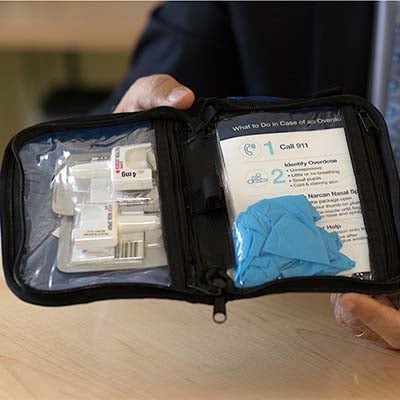END STIGMA.
SUSPEND JUDGMENT.
LEND A HAND.
As employers, you can help.

The Grayken Center for Addiction at Boston Medical Center (BMC) has designed a set of tools and resources to support your organization in understanding and addressing substance use disorders (SUDs). These tools are free to use, regardless of where or how your organization receives its medical care.
The library is organized in five sections, including tips on engaging your entire organization, ways to educate managers, and sample policies and practices. There are 25 downloadable tools to support making your strategy actionable. Workplaces have varying needs and capacity to institute changes, and not all 25 templates may be right for your organization. However, it's important that all employers begin to think about what they can do to make an impact and support their employees.
Resources and information in the Grayken Employer Resource Library are periodically updated and may not always be up-to-date. If you have any questions or concerns about this information, please reach out to Grayken.Center@bmc.org
Join Our Community
We welcome your comments, ideas, or sample practices and invite you to email them or let us know what you think to Grayken.Center@bmc.org.
What Should You Do First?
There are so many actions employers can take that it can seem overwhelming. But we suggest two simple ways to get started:
- Develop a cross-functional advisory team to determine what steps they can take within your organization.
- Review the mental health and substance use benefits coverage your company offers and ensure that it is comprehensive and affordable.
What's New?
- The Massachusetts Health Policy Forum, with support from RIZE Massachusetts, released a policy brief that outlines what some employers, including Boston Medical Center, Fishing Partnership Support Services, Seafood Sam's, The New England Carpenter's benefit Fund, and General Electric, have piloted for their own employees.
- Michael Botticelli wrote an article for Bay State Builder, the official Magazine of the Home Builders and Remodelers Association of Massachusetts, about what the industry can do to address this issue. In addition, Botticelli and Chief Human Resources Officer Lisa Kelly Croswell also spoke at a meeting hosted by the Associated General Contractors of Massachusetts. Read more about that event here.
- The Massachusetts Taxpayers Foundation, with support from RIZE Massachusetts, released a report on the massive economic impact of the opioid epidemic affecting hundreds of thousands of people, with costs to the state in the billions. Read the full report here.
- The President and CEOs of Partners HealthCare, Blue Cross Blue Shield Massachusetts and Boston Medical Center, published a Boston Globe piece on the employer's role in stemming the opioid epidemic, noting that "the business community can use its buying power, its ability to convene community stakeholders, and its respected voice to influence public policies, improve health care coverage, and focus funding in ways that will greatly accelerate the reduction of deaths and negative economic impacts caused by opioid use disorder." Read the entire article here.
- Ten Word Employee Stories
- What Survey Data is Saying
- State of the Epidemic
- SUD Cost Calculator
Assessing and Engaging the Organization
Substance use disorders (SUDs) are the most pressing public health crisis of our time and sadly, remain highly stigmatized. This section of the Resource Library will provide information and tools to help assess and engage your organization.
- SUD Cost Calculator
- Data Review: Medical and Disability Claims, EAP Utilization and Absences
- Employer Survey
- Focus Groups
- Communicating the State of the Epidemic
- Senior Level Commitment
- Cross-Functional Advisory Teams
- Gather and Share Personal Stories
- Assessing and Engaging the Organization Checklist
Empowering and Educating Managers
Managers are critical to communicating that your organization cares, and to facilitating access to SUDs information and resources. One way to help your managers is to clarify their role and provide training, tools and resources for them to assist their employees. This way, managers can help create a safe, confidential and stigma-free work environment.
- Frequently Asked Questions by Managers (FAQs)
- Sample Scenarios and Manager Tip Sheet
- SAMHSA’S Guidelines for Supervisors (Adapted)
- Empowering and Educating Managers Checklist
Supporting and Encouraging Employees
Your SUDs program for employees should help them better understand the SUDs epidemic, tools and resources that are available to them and their family members. It may be helpful to take advantage of annual organizational events like wellness week or a national effort like National Recovery Month, which takes place in September.
- Frequently Asked Questions by Employees (FAQs)
- Sample Scenarios and Employee Tip Sheet
- Employee Resource Guide
- Materials for Benefits Open Enrollment
- Supporting and Encouraging Employees Checklist
Supporting Employees’ Family Members
Employees may have family members struggling with a substance use disorder. There are several ways you can support these employees:
- Make sure they are educated about what benefits they and their family members may be entitled to, and are able to access evidence-based care. Resources to help families navigate the system are available here, and more information about treatment options is available here.
- Connect them with family support hotlines, including the Grayken Center’s free helpline for parents and families. See more information here.
- Consider setting up a family support group for employees, or connecting these employees with a family support group in your area.
- Make naloxone easily available, and encourage family members to pick up a kit just in case.
- See more resources available for families at SAMHSA.
Developing Policies and Practices
As you look to ramp up your SUDs support programs, this section will help you navigate through top-level thinking regarding policies, reviewing and enhancing company resources, and additional possible actions. This will also help you raise awareness of existing resources in your organization, work on reducing benefit spending, and create a more productive and engaged workforce.
- Benefits Coverage Questionnaire
- CASAColumbia Addiction Section for Insurance Plans
- Absence Management
- Organizational Polices
- Forming Support Groups
- National Recovery Month
- Naloxone On-site
- Developing Policies and Practices Checklist
National and Local Resources
Employee Support
In addition to being healthcare providers for the general public, Boston and Cambridge hospitals employ thousands of people, many of whom may need their own support with substance use. We propose that all hospitals commit to doing at least three of the following activities onsite, to encourage campus-wide discussion around substance use and increased uptake of needed health care support. Providing this support will impact thousands of employees, as well as their families and the broader community.
- Free onsite naloxone training + subsidized access to naloxone, where possible. (Naloxone costs are plan-dependent.)
- Survey the organization about employee & family need for substance use disorder support
- Review existing SUD benefits
- Send a specific SUD benefits guide to all employees
- Create an SUD Employee Support Policy.
- Develop a training for all managers regarding how to identify and support employees with substance use disorder needs
- Set up a family support group on site
- Hold a public event or town hall where people can tell their stories
- Send a letter from the CEO committing to SUD support and promoting a stigma-free workplace
- Share a pledge to encourage employees to use stigma-free language – i.e. “person with SUD” rather than “addict”




